Uniting Church (Church of the Good Shepherd)
Bexhill
1940 Leslie Somerville, Brisbane; Enl. 1979 Grant Virtue (2/12 electro-magnetic)
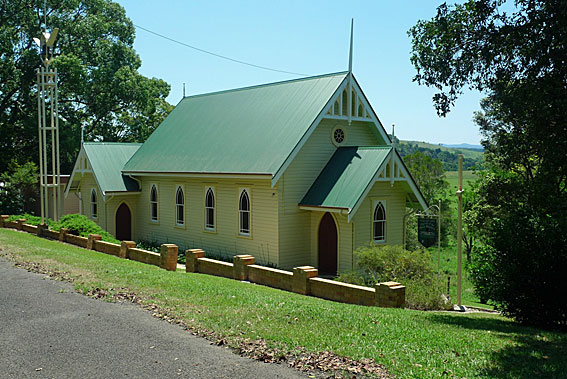
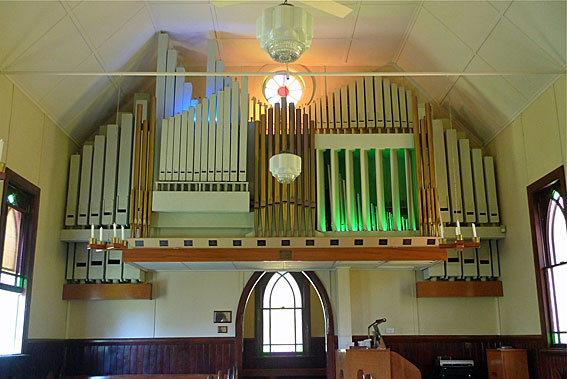
From 1998 OHTA Conference booklet:
The organ in this church has a rather complicated history. In its earliest form it was originally by Alfred Fuller of Kew, Melbourne, being this builder's second instrument in 1881. Intended for the Ipswich residenœ of Andrew Henry Barlow, he decided that it would be too powerful for his house and thereby made a successful offer to the Presbyterian Church in Ipswich.
In 1898 the organ sustained damage as a result of flooding and it was not until 1935 that Whitehouse Bros. totally rebuilt and electrified the organ. This instrument survived until 1953 when it was almost completely destroyed in a fire.
In 1940 a certain Leslie Robert Somerville completed an organ for his residence at Thistle Street, Gordon Park. This instrument incorporated parts salvaged from the Fuller organ in addition to bellows from the Brisbane City Hall following Willis' work there in 1927-29. After 12 years Leslie Somerville moved and had the organ stored. At this time Grant Virtue, organist at the Uniting (formerly Methodist) Church considered the possibility of obtaining a redundant organ. By December 1961 the Somerville organ had been purchased for £250. Over the next six months volunteer labour under the direction of H.W Jarrott saw the erection of this instrument. [1] The 1998 specification was: [2] [see below for 2006 specification]
| GREAT Open Diapason Stopped Diapason Open Flute SWELL Salicional PEDAL Bourdon Subbass Flute Quint Flute |
8 8 4 8 16 16 8 5-1/3 4 |
compass: 61/30
3 unison couplers
balanced swell pedal
electric action
[1] lnformation supplied by Grant Virtue, July 1998.
[2] lnformation supplied by K. Hastie, July 1998.
From SOJ Spring 2006:
Grant Virtue reports:
Bexhill, near Lismore in Northern NSW, is only a small country village. Its shopping centre comprises a combined post office - general store and a butcher's shop. Cattle graze around the Uniting Church, a small weatherboard building, erected in 1926 and which seats just 65 people.
In 1948 at 21 years of age, I became organist of the church. For the next fifteen years, as reed organist, I pumped and played and sometimes dreamed how nice it would be to have a pipe organ, for despite its small size, the church possessed a live acoustic. A new instrument, financially, would be out of the question. On the other hand, a small second hand pipe organ was a rarity 50 years ago.
However I decided to see if I could find something suitable. With little space and finance available, I concluded that "something suitable" would probably be a single manual tracker - no doubt quite elderly and in need of repairs. My eagerness to have a pipe organ told me that renovations and installation would need be taken care of by the 'do it yourself' method. I was a local dairy farmer and conveniently lived near the church.
Despite widespread enquiries to organ builders throughout Australia and in England only one small disused instrument was located and, wonder of wonders, it wasn't a single manual elderly tracker, it was a modern two manual and pedal pneumatic. It even had a concave and radiating pedalboard, as I discovered after making a 190 kilometre journey to Brisbane to see it. The organ had been built by a carpenter, Leslie Robert Somerville, for his own residence with the guidance of Whitehouse Bros who also supplied him with some redundant organ pipes and other components.
The organ was installed about 1940 but when Robert Somerville moved to another home a few years later he took his pipe organ with him and reinstalled it. When I located the organ in 1961 the owner had moved house yet again and the dismembered pipe organ was stored in boxes under two houses in different parts of Brisbane, which meant it could not be seen erected or heard and played. However the console, pipes and other components appeared to have been well made and the owner had decided not to re-erect the organ in his third residence. As he "had always hoped it might finish up in a church somewhere", he offered to let us purchase it for £250! The church agreed to buy it despite the fact that I didn't know how I was going to fit it into our small building.
The next problem was how to get the 3/4 tonne instrument 190 kilometres from Brisbane to Bexhill. Fortunately a church member offered the use of his farm truck and the organ was moved to Bexhill in his pig lorry! During the journey, the heavily laden pig lorry attracted quite a deal of attention and it was difficult convincing enquirers that our "load" was a pipe organ and not really a load of firewood. The first thing I had to do was to work out where to put the organ in the church. One day it suddenly occurred to me that I could bracket a shelf out from the rear wall about 5 metres wide and 1 metre deep, locate the swell box on one end and the pedal pipes and bellows on the other end. When I completed doing this I thought it looked really terrific but my mother, who had no faith in her son's organ building abilities, refused to sit under the gallery during services for about twelve months lest the whole affair should collapse and the gallery, swell box, bass pipes and bellows all come crashing down on her head.
The organ console is located directly below the gallery and the pneumatic action is very responsive. The organ was originally built with three stops on the Great - Open Diapason 8' Stopd Diapason 8' and Flute 4' but on the Swell there was only one Stop: an Oboe 8' and only to ten C, plus a swell octave coupler that affected only the Oboe. When I installed the organ I reversed the soundboards in order that the swell octave coupler would operate on the Open Diapason, Stopd Diapason and Flute, adding much variety of tone and brilliance.
I spent six months overhauling and installing the organ in our small church with guidance from time to time from a friend - organ builder H. W. Jarrott of Brisbane who spent a full week on the finishing of the organ. Upon completion it far exceeded all expectations and was dedicated on Sunday 22 July 1962 by Revd A. I. Buxton, minister of the church, whose sympathy with the project considerably helped a dream come true. The dedication attracted a huge congregation with more people outside the church than inside. Total cost was about £600, including the gallery. The organ console, gallery and various sets of pipes were all given as memorials or thank offerings which helped to finance the project. However as a Canon of St Paul's Cathedral London, is supposed to have once said to his organist "You organists are like old broken down English cab horses - always hoping for another stop!" This also applied to Bexhill.
In a very small building we didn't have a soft stop, and this was most necessary. Also there were enormous changes in temperature in our small building with its tin roof. Keeping the Oboe in tune was a real problem. We solved both problems by replacing the ten C Oboe with a Salicional rank that we secured from the residence organ of the late Arthur Lord of Killara NSW. We also found that the original pedal Bourdon 16' stop which was of extremely small scale was barely audible. To correct this the church empowered me to purchase a large scale Bourdon from a redundant organ if ever one should become available. I actually spent 17 years trying to find a large scale pedal bourdon before hearing that the 3 manual Roberts organ in Strathfield Uniting Church was being broken up. I made an immediate special trip to Sydney and found a pedal Bourdon of most generous scale 9-1/2 "x 7" on the bottom CCC pipe. But it was on direct blower wind and the pipes all had very high arched cut ups which meant it wouldn't work on the low wind pressure at Bexhill. I was extremely disappointed after having searched for 17 years, but on my trip home on the train it occurred to me that perhaps the old mouths could be cut out and new lower wooden mouths fitted. My organ builder friend in Brisbane confirmed that this would be possible but as this would involve a large amount of work he advised that I should not pay too much for the Strathfield pipes. When I phoned the Strathfield Church I was advised the pipes were still available "as nobody wanted them" and yes the church would accept a nominal offer as they were taking up storage space. I was also asked if I was aware that they were rather roughly made pipes. As a result of all this I made an offer of $50.00 for the rank of 42 pipes which the church accepted which worked out at $1.19 per pipe!
Some pipe feet had to be replaced due to borer damage and although cutting out the old mouths and shaping and fitting new lower mouths was a very big undertaking, the stop nevertheless turned out splendidly. I had to design five new chests so the pipes could be fitted where space was available and a local church member made up the new chests for me. These were fitted with direct electric pallet magnets and the extended rank made playable at 16', 8', 5-1/3' and 4' pitches adding much weight of tone and variety to the pedal.
There are some more improvements that have taken place during the last 50 years. The original wood Stopd Diapason 8' on the manual was always disappointing to me, being very husky in tone. The late Walter Emmerson of Toowoomba made up an entirely new wood Stopd Diapason 8', the final voicing being carried out in Sydney by Paul Fulcher when head voicer of Walkers Australia. This is a splendid stop as are the other manual stops.
I have always loved pedal reeds and recently a former Telecom employee and organist designed and installed on the pedals an electronic Trombone 16' and Trumpet 8,' both being very effective. Lastly I have just added a 1 1/3' mutation (using pipes) which gives a very chirpy tone.
We feel our church could be the smallest in Australia to have a pipe organ this size. It has a very classical tone and recitals have been given by Heather Moen-Boyd (Sydney), Graeme Rawson (Sydney), Steven Nisbet (Brisbane), Eric Spencer (when organist and master of the Choristers St Peters Brighton, England). The latest recital was given by young Canberra organist Frank Tamsitt, now furthering his studies at the Kings School, Gloucester Cathedral U.K. Frank concluded his Bexhill recital with a brilliant rendition of Widor's Toccata. The very effective tremulant operates on all of the manual stops, making the organ also ideal for popular music. Sydney Theatre organist David Parsons has travelled especially to Bexhill each Springtime for the last 15 years to present popular concerts and these are usually attended by about 200 people. It is usual to have two coach loads from the Gold Coast and some visitors from Brisbane. We always have a coach load from Brisbane for our annual Carols by Candlelight which includes a half hour organ recital by Warren Whitney, organist of the Lismore Anglican Church and Catholic Cathedral.
In recent years members of the Queensland Organ Society have visited the organ as well as members of the Organ Historical Trust of Australia during their annual conference. Visitors are always welcome to see and try this interesting organ.
The specification is now:
| Great Salicional Swell Open Diapason Stopd Diapason Flute (wood) Quint Tremulant Pedal Bourdon Sub Bass Bass Flute Quint Flute Trombone Trumpet Couplers Sw/Gt Sw Oct Sw/Ped. |
8 8 8 4 1-1/3 16 16 8 5-1/3 4 16 8 |
(electronic) (electronic) |
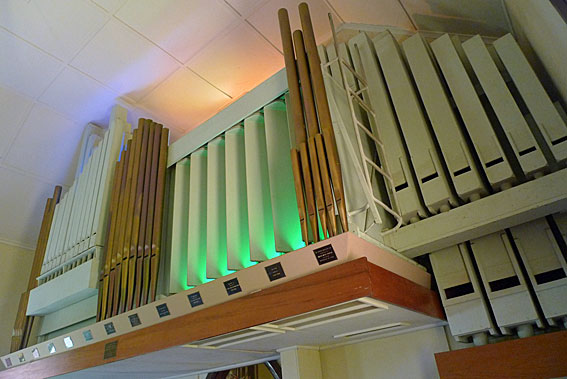
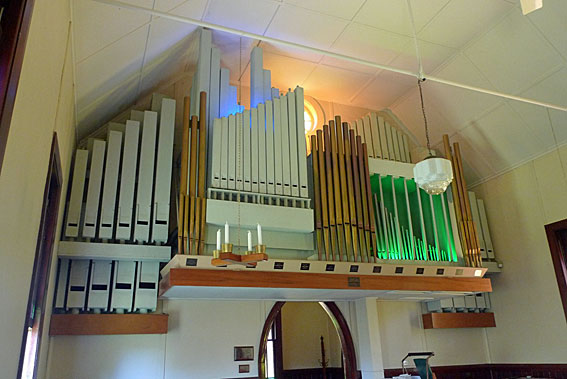
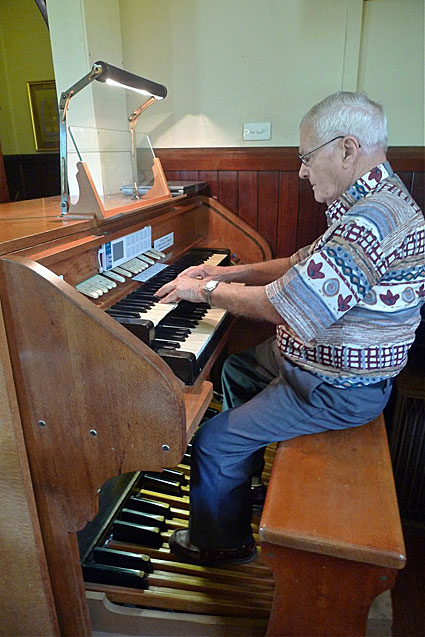
Organbuilder, Grant Virtue, at console
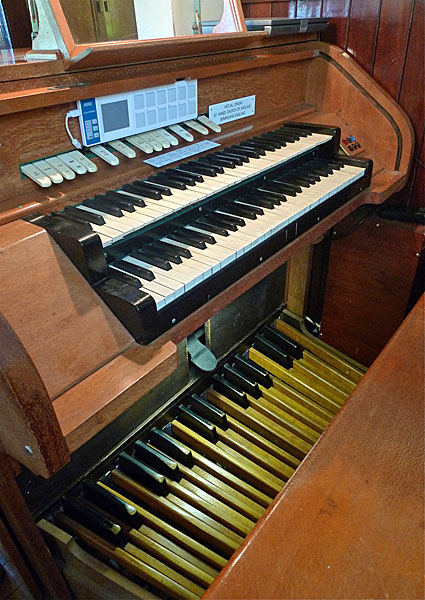
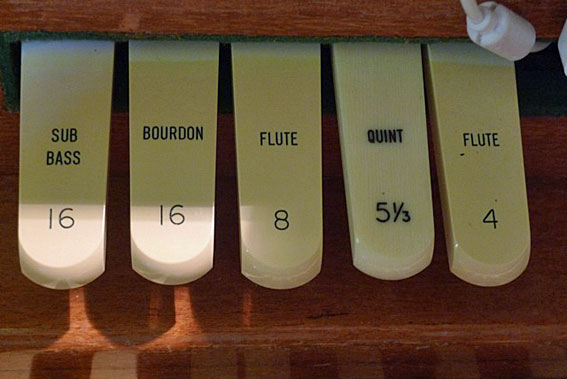
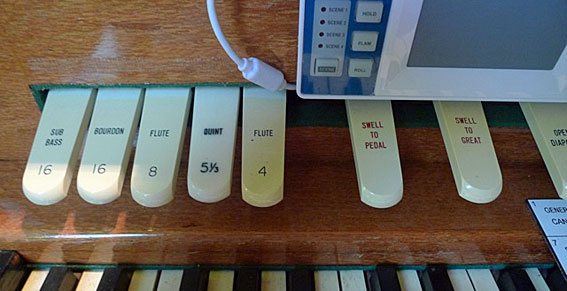
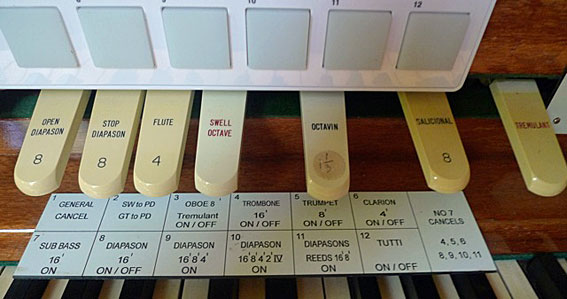
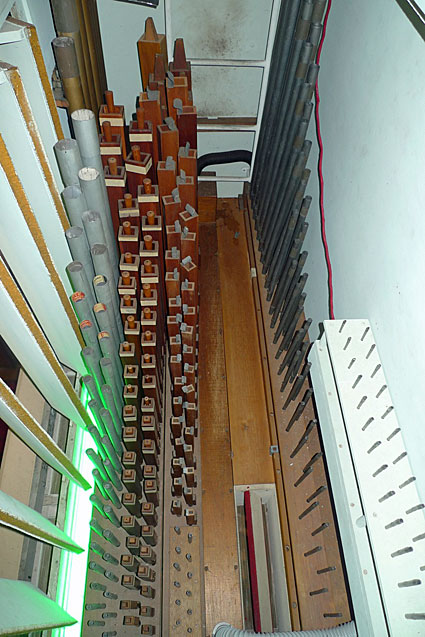
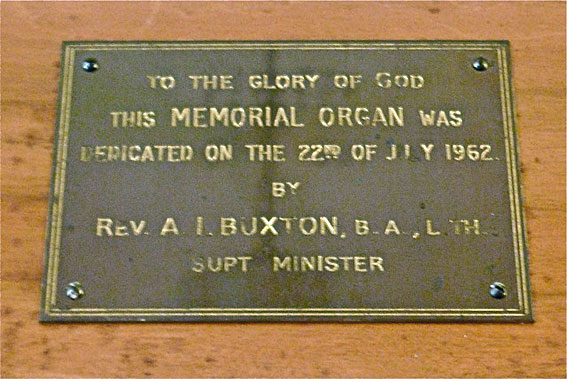
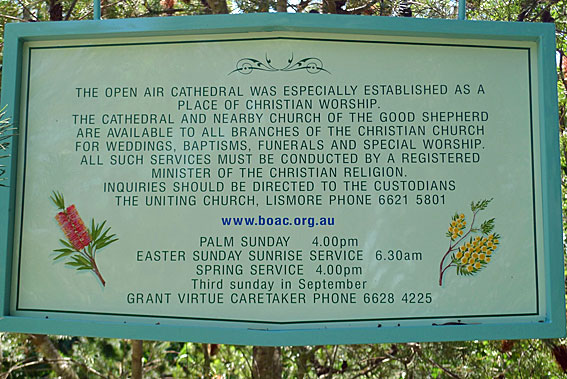

Photos: Trevor Bunning (November 2011)